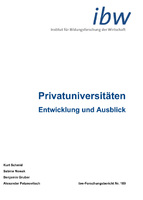
Lehrlingsausbildung im Überblick 2017
Strukturdaten, Trends und Perspektiven
Der lang anhaltende (primär demographisch bedingte) Rückgang an Lehrlingen und Lehrbetrieben konnte zumindest bei den NeuanfängerInnen beendet werden. Der Ausbildungserfolg der Lehrlinge hängt stark von Vorbildung, Stadt/Land, Staatsbürgerschaft, Branche und Lehrbetriebsgröße ab. Auch der anschließende Erfolg am Arbeitsmarkt wird in hohem Maße von regionalen Faktoren beeinflusst. Diese und viele andere Aspekte betreffend die Lehrlingsausbildung in Österreich sowie im europäischen Vergleich untersucht die aktuelle Ausgabe der jährlich erscheinenden (von BMWFW und WKÖ geförderten) ibw-Publikation „Lehrlingsausbildung im Überblick“, welche einen aktuellen Querschnitt über die verfügbaren statistischen Daten zur Lehrlingsausbildung in Österreich zeigt.
Die Print-Ausgabe kann für einen Druckkostenbeitrag von 17 Euro bestellt werden. Der Versand erfolgt kostenfrei.
The previous prolonged decline in the number of apprentices and training companies (which was mainly due to demographic reasons) has now been stopped, at least among apprenticeship beginners. The training success of apprentices very much depends on their previous education, the place (town or countryside), their nationality, the sector and the size of the training company. Their subsequent success on the labour market is also influenced greatly by regional factors. These and many other aspects related to apprenticeship training in Austria and in a European comparison are explored in the latest issue of the ibw publication “Survey of Apprenticeship Training”, which comes out every year (with funding provided by the Federal Ministry of Science, Research and Economy BMWFW and the Austrian Federal Economic Chamber WKO) and provides an overview of currently available statistical data on apprenticeship training in Austria.
